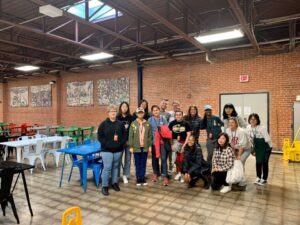Written by Lauren Johns

Fall Break Immersion
The day I received the email about my acceptance to a Bear Breaks venture in Oklahoma City, I was ecstatic. I always admired those people who visited foreign countries and spent months rebuilding and contributing to the healing process, whether the damage be from a natural disaster or merely the poverty line. This was especially prominent when I spent 11 days in Kathmandu, the capital of Nepal, for a hiking and sightseeing trip. The 2015 earthquake had devastated the land, leaving gaping holes in the sidewalks and thousands of people homeless. My grandpa was able to donate a large sum of money to the reconstruction. I admired him for it and this admiration sparked something in me. A desire to be immersed in the change.
Aside from donations, volunteers in foreign lands can only spend a small portion of their time there, due to cost and distance. However, Bear Breaks stresses the fact that people are struggling everywhere, leading to local trips like Texas, Chicago and St. Louis with different themes (the Oklahoma trip focused on hunger and homelessness). In addition, Bear Breaks strives to return to the same areas as well, avoiding that ‘one and done’ mentality by focusing on building partnerships in communities. You don’t have to fly across the world, be a public figure or start a big campaign to alter unfortunate circumstances.
Serving in Oklahoma City
In Oklahoma, we served a meal to hundreds of homeless individuals at City Rescue Mission. My wrist was burning after over an hour of scooping mashed potatoes at lightning speed. We also packaged frozen chicken in a freezer and nicknamed it the ‘chicken prison’—but ‘the chicken powerhouse’ seems like a better fit because of all the meals that chicken will create. I felt incredibly empowered at the work we’d done. The remainder of the group sorted and packaged produce and assembled weekend food bags for students (both jobs done at the Regional Food Bank). The final full day, we learned about urban gardening and cleared out future flower beds, which will produce flowers that can be sold by individuals through the Homeless Alliance to increase their income and help them get back on their feet.
Now what?
Most people don’t realize how exploited the homeless are. On a daily basis, they are ridiculed, laughed at, or subjected to other dehumanizing behaviors. For example, I’ve seen people take pictures for social media as if that homeless man on the bench was some stray dog and not a human being. That’s another reason why this trip was worthwhile—it was a chance to challenge the way we think about homelessness every day.
Despite a few bumps in the road (like the day some teenagers broke into the church we were staying at to play with the fire extinguisher), it was the most fulfilling three days of my life. And I met some fabulous new friends as well. I would definitely recommend this opportunity to anyone who wants a greater perspective on the hidden issues of society. It’s time to shine some light on the downtrodden and the underlying causes of homelessness.
